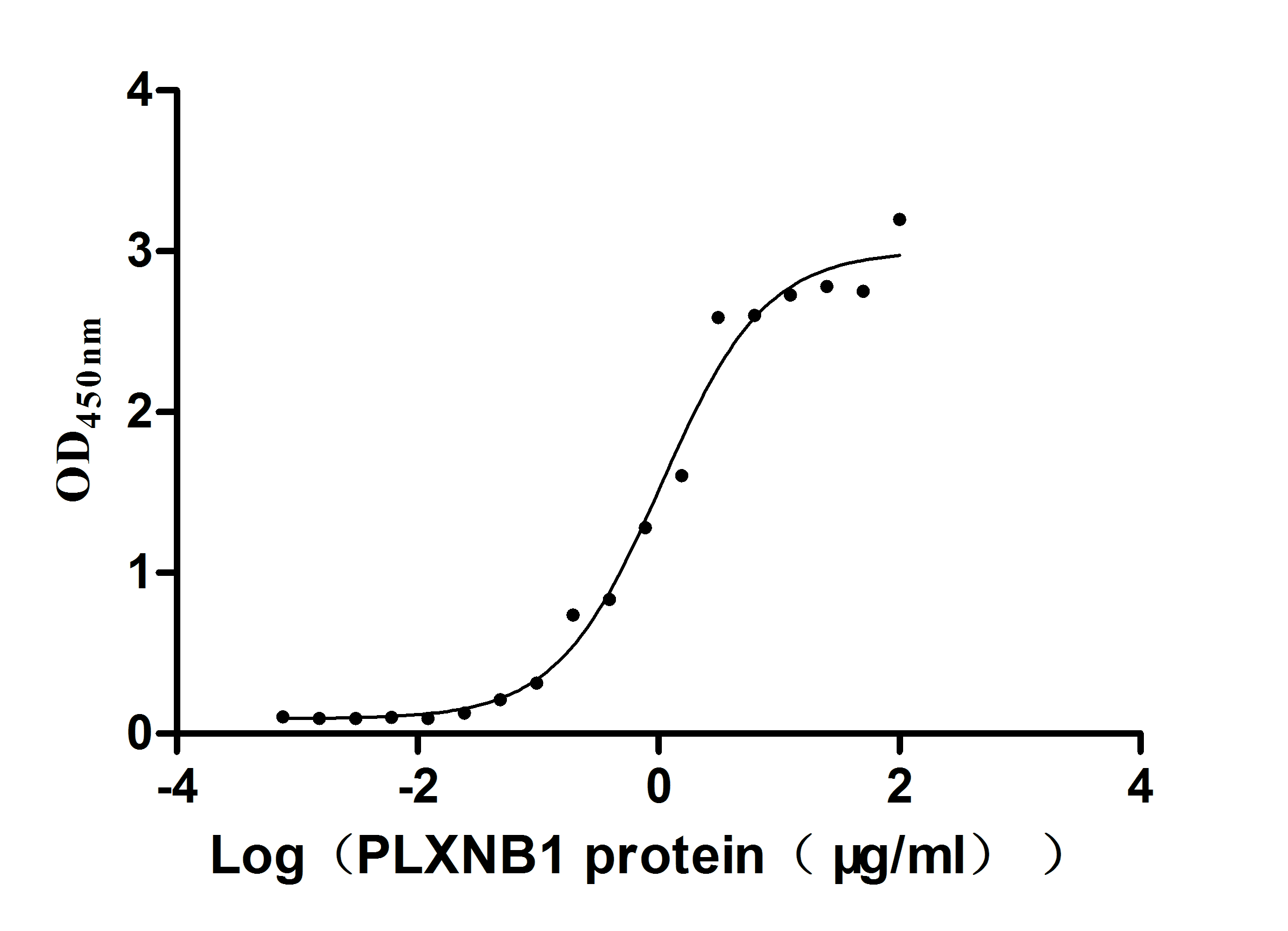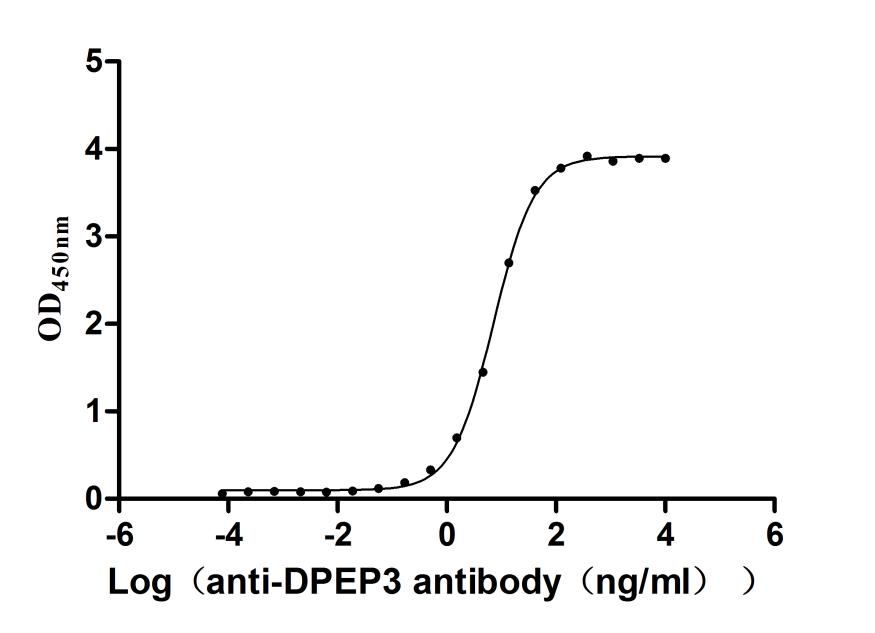Recombinant Mouse Tumor necrosis factor ligand superfamily member 18 (Tnfsf18), partial
-
中文名称:小鼠Tnfsf18重组蛋白
-
货号:CSB-YP749268MO
-
规格:
-
来源:Yeast
-
其他:
-
中文名称:小鼠Tnfsf18重组蛋白
-
货号:CSB-EP749268MO
-
规格:
-
来源:E.coli
-
其他:
-
中文名称:小鼠Tnfsf18重组蛋白
-
货号:CSB-EP749268MO-B
-
规格:
-
来源:E.coli
-
共轭:Avi-tag Biotinylated
E. coli biotin ligase (BirA) is highly specific in covalently attaching biotin to the 15 amino acid AviTag peptide. This recombinant protein was biotinylated in vivo by AviTag-BirA technology, which method is BriA catalyzes amide linkage between the biotin and the specific lysine of the AviTag.
-
其他:
-
中文名称:小鼠Tnfsf18重组蛋白
-
货号:CSB-BP749268MO
-
规格:
-
来源:Baculovirus
-
其他:
-
中文名称:小鼠Tnfsf18重组蛋白
-
货号:CSB-MP749268MO
-
规格:
-
来源:Mammalian cell
-
其他:
产品详情
-
纯度:>85% (SDS-PAGE)
-
基因名:
-
Uniprot No.:
-
别名:Tnfsf18; Gitrl; Tumor necrosis factor ligand superfamily member 18; GITR ligand; GITRL; Glucocorticoid-induced TNF-related ligand
-
种属:Mus musculus (Mouse)
-
蛋白长度:Partial
-
蛋白标签:Tag type will be determined during the manufacturing process.
The tag type will be determined during production process. If you have specified tag type, please tell us and we will develop the specified tag preferentially. -
产品提供形式:Lyophilized powder
Note: We will preferentially ship the format that we have in stock, however, if you have any special requirement for the format, please remark your requirement when placing the order, we will prepare according to your demand. -
复溶:We recommend that this vial be briefly centrifuged prior to opening to bring the contents to the bottom. Please reconstitute protein in deionized sterile water to a concentration of 0.1-1.0 mg/mL.We recommend to add 5-50% of glycerol (final concentration) and aliquot for long-term storage at -20℃/-80℃. Our default final concentration of glycerol is 50%. Customers could use it as reference.
-
储存条件:Store at -20°C/-80°C upon receipt, aliquoting is necessary for mutiple use. Avoid repeated freeze-thaw cycles.
-
保质期:The shelf life is related to many factors, storage state, buffer ingredients, storage temperature and the stability of the protein itself.
Generally, the shelf life of liquid form is 6 months at -20°C/-80°C. The shelf life of lyophilized form is 12 months at -20°C/-80°C. -
货期:Delivery time may differ from different purchasing way or location, please kindly consult your local distributors for specific delivery time.Note: All of our proteins are default shipped with normal blue ice packs, if you request to ship with dry ice, please communicate with us in advance and extra fees will be charged.
-
注意事项:Repeated freezing and thawing is not recommended. Store working aliquots at 4°C for up to one week.
-
Datasheet :Please contact us to get it.
靶点详情
-
功能:Cytokine that binds to TNFRSF18/AITR/GITR. Regulates T-cell responses. Can function as costimulator and lower the threshold for T-cell activation and T-cell proliferation. Important for interactions between activated T-lymphocytes and endothelial cells. Mediates activation of NF-kappa-B. Triggers increased phosphorylation of STAT1 and up-regulates expression of VCAM1 and ICAM1. Promotes leukocyte adhesion to endothelial cells. Regulates migration of monocytes from the splenic reservoir to sites of inflammation.
-
基因功能参考文献:
- the upregulation of IFN-beta in DCs induces the up-regulation of coinhibitory molecules B7H1 and GITRL, which cause an impaired activation of naive Ag-specific T cells PMID: 25144375
- GITRL expressed on macrophages drives cytokine release and T cell activation, resulting in neuropathic pain via GITR-dependent actions. The GITRL-GITR pathway might represent a novel target for the treatment of neuropathic pain. PMID: 25787078
- Down-regulation of GITRL enhances CD8 T cell responses to chronic lymphocytic choriomeningitis virus. PMID: 25281716
- Sjogren's syndrome-like autoimmune sialadenitis in MRL-Faslpr mice is associated with expression of glucocorticoid-induced TNF receptor-related protein (GITR) ligand and 4-1BB ligand. PMID: 23301790
- GITRL triggering in endothelial cells increases leukocyte adhesion and transmigration. PMID: 23892569
- The B7H1 and GITRL molecules may play an important role in TGF-beta-induced Treg expansion of lung cancer microenvironment. PMID: 22614805
- results demonstrate that enhanced GITR/GITRL interactions have a pleiotropic role on the regulation of T-cell responses PMID: 22678896
- B cell expression of GITRL induced Treg proliferation, maintaining their numbers above a threshold required for the prevention of autoimmunity. PMID: 22368274
- Findings suggest GITRL could enhance the immune stimulation of DC and might facilitate the potential development of DCs-based anti-tumor therapies. PMID: 21186078
- GITRL-dependent expansion of Treg within the cornea is one mechanism underlying immune privilege in corneal allografts. PMID: 20702832
- GITR and GITRL are functionally expressed on brain microglia and that the stimulation of GITRL can induce inflammatory activation of microglia. The GITR/GITRL system may play an important role in neuroinflammation. PMID: 20162721
- TRAIL- and GITRL-activated pathways synergise in the development of SCI-related inflammatory damage. PMID: 20107429
- GITROL ligation of the costimulatory molecule GITR on Tregs inhibits their ability to promote graft survival. Blocking GITRL with a soluble GITR fusion protein prolongs graft survival. PMID: 20148423
- the GITR/GITRLigand pathway has a key role in the development of murine autoimmune diabetes PMID: 19936238
- glucocorticoid-induced tumor necrosis factor receptor ligand is costimulatory for T cells PMID: 14608036
- A soluble form of mouse GITR ligand (sGITR-L) induces GITR-dependent NF-kappa B activation and blocks in vitro suppression mediated by both resting and preactivated polyclonal and antigen-specific regulatory T (Treg) cells. PMID: 15128759
- GITR-L provides an important signal for CD25- T cells, rendering them resistant to CD25+ -mediated regulation at the initiation of the immune response. PMID: 15470044
- specific oligomeric forms of GITRL may be used as a means to differentially control GITR receptor signaling in diverse cells PMID: 18178614
- the unique structural and biochemical behavior of mouse GITRL, along with the unusual domain organization of murine GITR, support a previously unrecognized mechanism for signaling within the TNF superfamily PMID: 18182486
- GITRL-costimulation augments both effector and regulatory functions of CD4(+) T cells. PMID: 18346459
- signaling between GITR-L and GITR in the tumor microenvironment promotes the infiltration of CD8+ T cells, which are essential for controlling tumor growth. PMID: 19018533
- The GITR-GITR ligand pathway, mediated by interactions with epidermal keratinocytes and Langerhans cells, promotes cutaneous dendritic cell migration and hapten-specific T cell responses. PMID: 19234165
- during fungal infection, GITRL-GITR interaction modulates TLR-4 and TLR-2 expression, thereby altering the antigen presentation process, and suggesting a role of GITRL-GITR interaction in resistance against infectious diseases. PMID: 19272591
- The S2 cell-expressed murine GITRL adopts an identical ;strand-exchanged' dimeric structure to that observed for the E. coli-expressed protein, thus conclusively demonstrating the novel quaternary structure assembly behavior of murine GITRL. PMID: 19390148
- keratinocytes express GITRL, and that through this important co-stimulatory molecule, they have the potential to influence T-cell numbers in the skin through chemokine production and through a direct cell-cell effect on T-cell proliferation PMID: 19536139
- GITRL requires trimer stabilization for activation PMID: 19596991
显示更多
收起更多
-
亚细胞定位:Cell membrane; Single-pass type II membrane protein.
-
蛋白家族:Tumor necrosis factor family
-
组织特异性:Detected in immature and mature dendritic cells and in macrophages (at protein level). Detected in spleen, lung, heart, thymus, monocytes, macrophages, B-cells and dendritic cells.
-
数据库链接:
KEGG: mmu:240873
STRING: 10090.ENSMUSP00000083251
UniGene: Mm.276823
Most popular with customers
-
Recombinant Human Plexin-B1 (PLXNB1), partial (Active)
Express system: Mammalian cell
Species: Homo sapiens (Human)
-
Recombinant Human Tumor-associated calcium signal transducer 2 (TACSTD2), partial (Active)
Express system: Mammalian cell
Species: Homo sapiens (Human)
-
Recombinant Human C-type lectin domain family 4 member C (CLEC4C), partial (Active)
Express system: Mammalian cell
Species: Homo sapiens (Human)
-
Recombinant Human Cytotoxic and regulatory T-cell molecule (CRTAM), partial (Active)
Express system: Mammalian cell
Species: Homo sapiens (Human)
-
Recombinant Human Dipeptidase 3(DPEP3), partial (Active)
Express system: Mammalian cell
Species: Homo sapiens (Human)
-
Recombinant Human Interleukin-1 receptor accessory protein (IL1RAP), partial (Active)
Express system: Mammalian cell
Species: Homo sapiens (Human)
-
Express system: Mammalian cell
Species: Homo sapiens (Human)



















